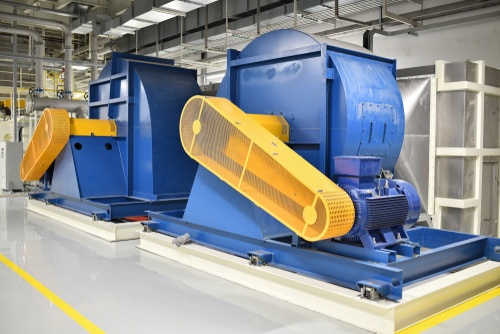What is the Difference Between Fans and Blowers?

HVAC systems rely on ventilation equipment for space heating and air conditioning, since chillers and boilers by themselves cannot deliver the heating or cooling effect where it is required. In addition, ventilation systems ensure a constant supply of fresh air for indoor spaces. Based on the pressure and airflow requirements of each application, either a fan or a blower is used.
Before discussing the main types of fans and blowers, it is important to understand the difference between both concepts. The American Society of Mechanical Engineers (ASME) defines fans and blowers based on the ratio between discharge pressure and suction pressure.
- Fan: Pressure ratio up to 1.11
- Blower: Pressure ratio from 1.11 to 1.2
- Compressor: Pressure ratio exceeds 1.2
Fans and blowers are necessary for air to overcome the flow resistance caused by components like ducts and dampers. There are many types available, each suited for certain applications. Choosing the right type helps optimize HVAC performance, while poor selection leads to energy waste.
Improve your indoor air quality with a professional ventilation design.
Types of Fans
Fans can be classified into centrifugal or axial based on how they establish airflow. In turn, there are several subtypes in each category, and choosing a fan that matches the application is critical for a high-performance HVAC installation.
The following table summarizes the main types of centrifugal fans: radial, forward curved, backward curved and airfoil type.
|
FAN TYPE |
DESCRIPTION |
|
Radial |
-High pressure and medium flow |
|
Forward curved |
-Medium pressure and high flow |
|
Backward curved |
-High pressure and high flow |
|
Airfoil |
-High pressure and high flow |
On the other hand, axial flow fans are classified into propellers, tube axial and vane axial.
|
FAN TYPE |
DESCRIPTION |
|
Propeller |
-Low pressure and high flow, low efficiency |
|
Tube axial |
-Medium pressure and high flow |
|
Vane axial |
-High pressure and medium flow, high efficiency |
With such a wide selection of fans, there is a solution for almost any application. However, variety also means there is higher chance of selecting the wrong fan without proper guidance. The best recommendation is to avoid “rule of thumb” decisions, and instead get a professional design that meets the needs of your project.
Types of Blowers
As previously stated, blowers operate with a pressure ratio of 1.11 to 1.2, which makes them intermediate between a fan and a compressor. They can produce much higher pressures than fans, and they are also effective in industrial vacuum applications that require negative pressurization. Blowers are divided into two main categories: centrifugal and positive displacement.

Centrifugal blowers have some physical similarity with centrifugal pumps. They normally include a gear system to achieve speeds well over 10,000 rpm. Centrifugal blowers can have a single-stage or a multi-stage construction, where the single-stage design offers a higher efficiency, but the multi-stage design provides a wider airflow range at steady pressure.
Like fans, centrifugal blowers have applications in HVAC. However, thanks to their superior pressure output, they are also used in cleaning equipment and automotive applications. Their main limitation is that airflow decreases rapidly when an obstacle raises pressure, making them unsuitable for applications with a high chance of clogging.
Positive-displacement blowers have a rotor geometry designed to capture pockets of air, driving flow in the intended direction at high pressure. Although they rotate at lower speeds than centrifugal blowers, they can produce enough pressure to blow away objects clogging the system. Another important difference with centrifugal options is that positive-displacement blowers are typically driven by belts instead of gears.
Conclusion
Fans and blowers are normally specified based on the pressure and airflow requirements of each application, as well as site-specific conditions such as dust and temperature. Once the right type of fan or blower has been specified, performance can normally be enhanced with control systems. For example, variable frequency drives (VFD) can drastically reduce the electricity consumption of fans that operate intermittently.
Make sure your mechanical installations are code compliant and energy efficient, while getting a 50% faster turnaround. You can contact Nearby EngineersNew York Engineers by email (info@ny-engineers.com) or phone (786) 788-0295212-575-5300.

Michael Tobias
Michael Tobias, the Founding Principal of NY Engineers, currently leads a team of 150+ MEP/FP engineers and has led over 4,000 projects in the US
Join 15,000+ Fellow Architects and Contractors
Get expert engineering tips straight to your inbox. Subscribe to the NY Engineers Blog below.

